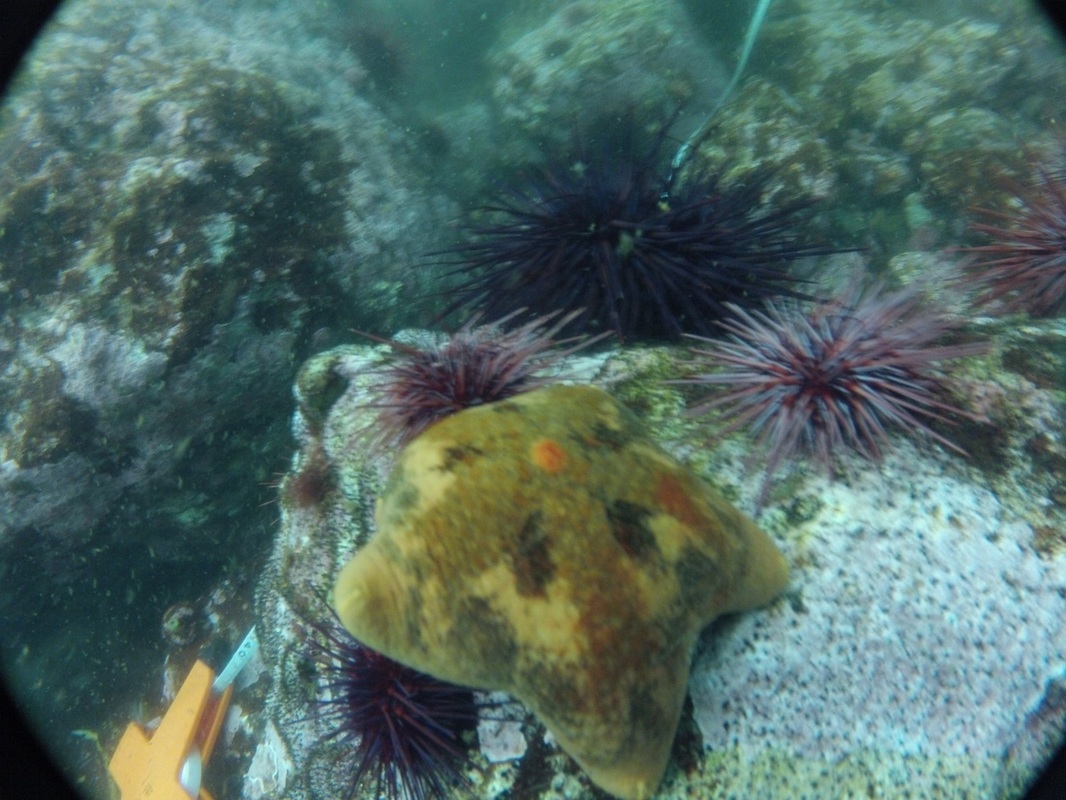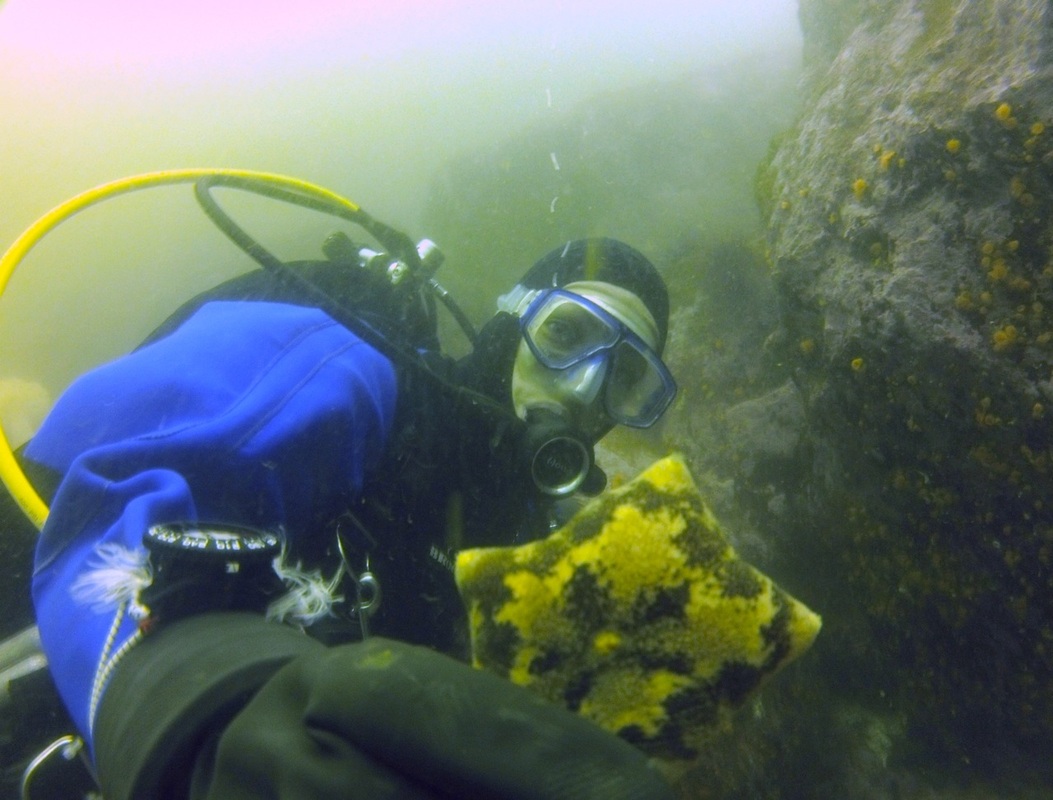Slime star, cushion star • Pteraster tesselatus
{tesselatus = inlaid with small squares, likely a reference to the checkered pattern that is often observed}
Identification
The slime star gets its common name from the large amounts of thick, slimy mucous that it produces when stressed by potential predators (including curious beachcombers and divers). Its five rays are short and stubby, which, along with a broad central disc, give it an overall inflated appearance. Instead of a madreporite it has an elevated pore in the centre of the upper, or aboral, side of its body. This sea star gets to 24 cm in diameter. It is usually tan, though it ranges from yellow and cream to greyish, and may be mottled with brown or marked with a checkered pattern. Rare individuals may have more than 5 arms.
Habitat & Range
The slime star inhabits rocky locations, and may be found on both solid rock and substrates of broken rock. It can be found from the subtidal to a depth of 435 m. Its range extends from the Bering Sea to Central California. It is also reported in Japan. Some sources report a subspecies, Pteraster tesselatus arcuatus, but the validity of this subspecies is unclear and it may in fact be just a synonym for P. tesselatus.
Similar Species
The wrinkled star (P. militaris) has wrinkled skin and longer arms than the slime star.
Intriguing Info
The slime star must be kept separate from other species when in an aquarium, as the large amounts of slime it produces when stressed could greatly impact other animals in close quarters. Its ability to produce this slime is connected with its respiratory system and the presence of a raised central pore instead of the usual closed madreporite on its aboral side. Click here to learn about this unusual respiratory system. Check out the Hakai Wild video below to see this slime in action.
iNaturalist
https://www.inaturalist.org/taxa/194701-Pteraster-tesselatus
The slime star gets its common name from the large amounts of thick, slimy mucous that it produces when stressed by potential predators (including curious beachcombers and divers). Its five rays are short and stubby, which, along with a broad central disc, give it an overall inflated appearance. Instead of a madreporite it has an elevated pore in the centre of the upper, or aboral, side of its body. This sea star gets to 24 cm in diameter. It is usually tan, though it ranges from yellow and cream to greyish, and may be mottled with brown or marked with a checkered pattern. Rare individuals may have more than 5 arms.
Habitat & Range
The slime star inhabits rocky locations, and may be found on both solid rock and substrates of broken rock. It can be found from the subtidal to a depth of 435 m. Its range extends from the Bering Sea to Central California. It is also reported in Japan. Some sources report a subspecies, Pteraster tesselatus arcuatus, but the validity of this subspecies is unclear and it may in fact be just a synonym for P. tesselatus.
Similar Species
The wrinkled star (P. militaris) has wrinkled skin and longer arms than the slime star.
Intriguing Info
The slime star must be kept separate from other species when in an aquarium, as the large amounts of slime it produces when stressed could greatly impact other animals in close quarters. Its ability to produce this slime is connected with its respiratory system and the presence of a raised central pore instead of the usual closed madreporite on its aboral side. Click here to learn about this unusual respiratory system. Check out the Hakai Wild video below to see this slime in action.
iNaturalist
https://www.inaturalist.org/taxa/194701-Pteraster-tesselatus
References
Cowles, D. (2005). Pteraster tesselatus Ives, 1888. Invertebrates of the Salish Sea. Rosario Beach Marine Laboratory. Accessed 12/02/2015.
Harbo, R. M. (2011). Whelks to whales: Coastal marine life of the Pacific Northwest [revised]. Madeira Park, BC: Harbour Publishing. P. 173.
Lamb, A., and Hanby, B. (2005). Marine Life of the Pacific Northwest [electronic version]. Madeira Park, BC: Harbour Publishing.
Lambert, P. Pteraster tesselatus Ives, 1888. In Klinkenberg, Brian. (Ed.) E-Fauna BC: Electronic Atlas of the Fauna of British Columbia. Lab for Advanced Spatial Analysis, Department of Geography, University of British Columbia, Vancouver. Accessed 12/02/2015.
Authors and editors of page
Kelly Fretwell and Brian Starzomski (2015).
Cowles, D. (2005). Pteraster tesselatus Ives, 1888. Invertebrates of the Salish Sea. Rosario Beach Marine Laboratory. Accessed 12/02/2015.
Harbo, R. M. (2011). Whelks to whales: Coastal marine life of the Pacific Northwest [revised]. Madeira Park, BC: Harbour Publishing. P. 173.
Lamb, A., and Hanby, B. (2005). Marine Life of the Pacific Northwest [electronic version]. Madeira Park, BC: Harbour Publishing.
Lambert, P. Pteraster tesselatus Ives, 1888. In Klinkenberg, Brian. (Ed.) E-Fauna BC: Electronic Atlas of the Fauna of British Columbia. Lab for Advanced Spatial Analysis, Department of Geography, University of British Columbia, Vancouver. Accessed 12/02/2015.
Authors and editors of page
Kelly Fretwell and Brian Starzomski (2015).






